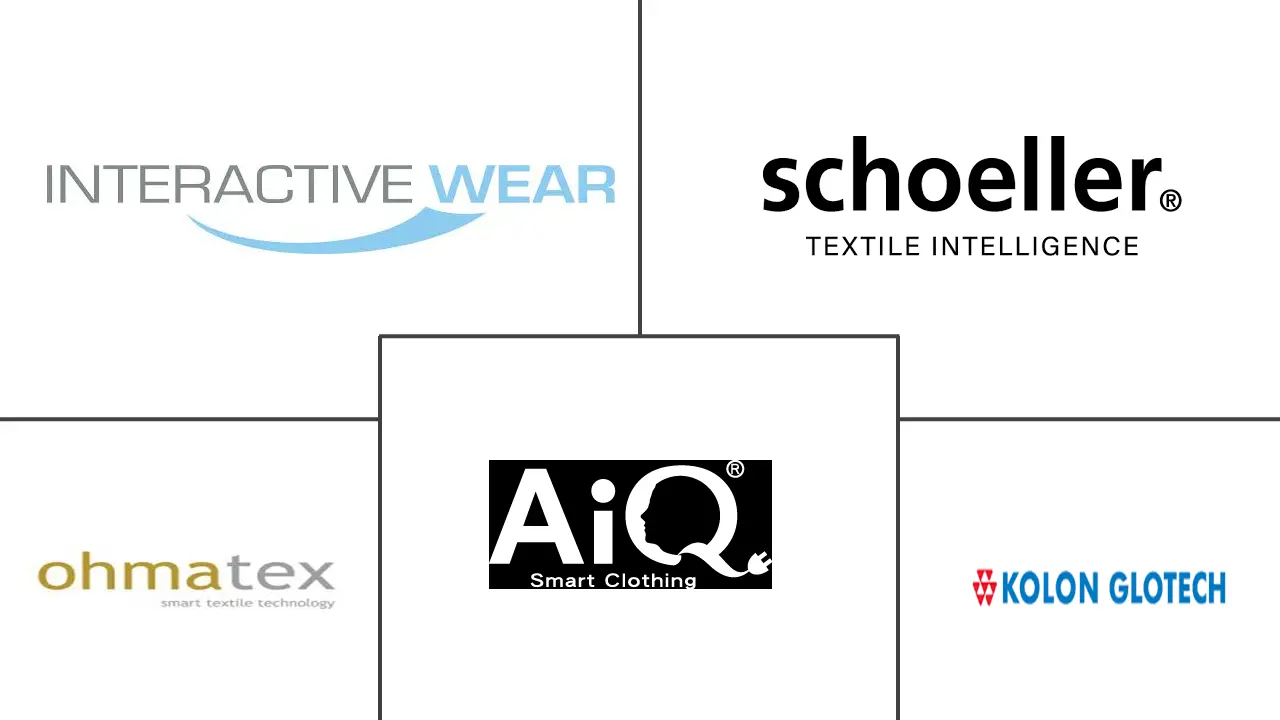Smart Fabrics For Transportation Market Size and Share
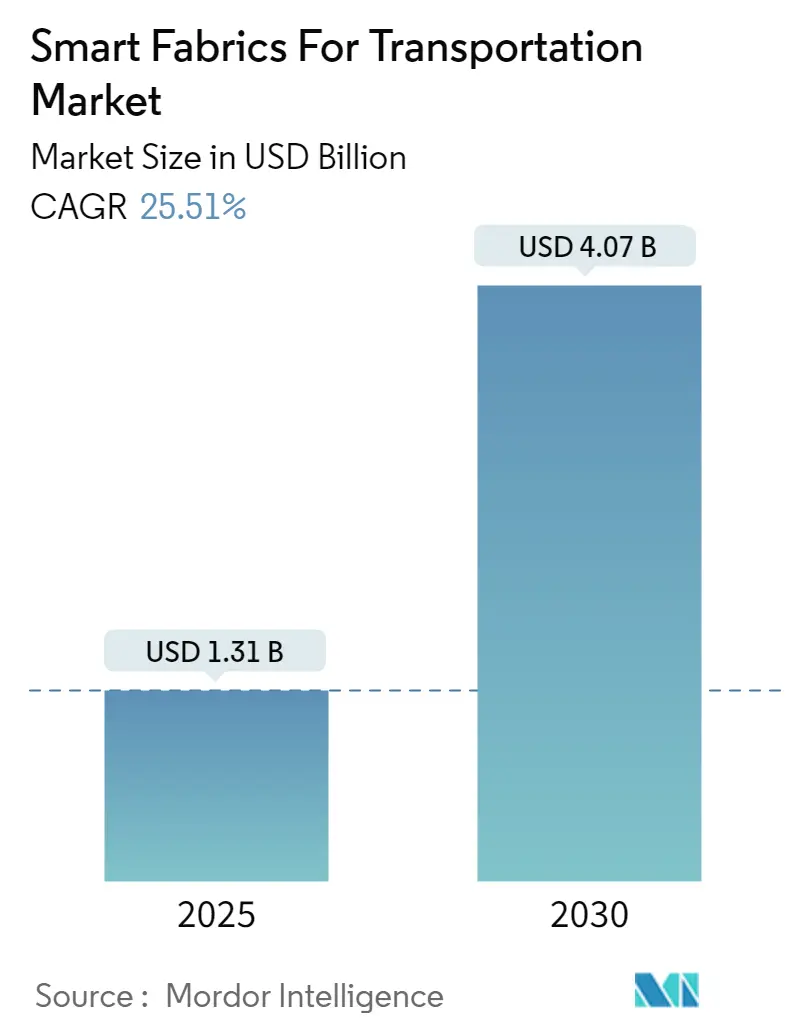
Smart Fabrics For Transportation Market Analysis by Mordor Intelligence
The Smart Fabrics For Transportation Market size is estimated at USD 1.31 billion in 2025, and is expected to reach USD 4.07 billion by 2030, at a CAGR of 25.51% during the forecast period (2025-2030).
- The electronics industry's drastic technological advancement has changed how people do and perceive things. The Internet of Things has connected everything. Smart fabrics are a crucial part of this technological advancement, playing a significant role in the future, with applications in the transportation industry.
- The miniaturization of various electronic components and the emergence of various advanced polymers are driving the market forward. Also, with the development of fabrics with antistatic properties, tremendous stain-proof capabilities and the overall ability of fabrics to interact with the environment, which further helps regulate temperature, are offered. These critical properties of smart fabrics have enabled their use in automotive vehicles.
- Moreover, the use of fabrics in automobiles is not only restricted to upholstery, but they are also widely used in floor mats, seat belt webbings, the interior ceiling, steering wheel, interior door panels, and gear shift covers. Additionally, fabrics are not only meant for the exterior surfaces, which are visible but are also used in the preparation of insulation for thermal control inside the vehicle. The versatile nature of the fabrics has made them a crucial component of automobiles, driving the market forward.
- The increasing adoption of bluetooth low energy (BLE) technology and miniaturization of electronic components is a crucial driver for the smart fabrics for transportation market growth. The BLE technology-enabled garments can sense and monitor data when connected to the Internet. There has been a rising trend of miniaturization of electronic components and systems, which has expedited the need for smaller assembly components for manufacturing smart fabrics. Radical developments in wireless and electronic technologies have enabled miniaturization and their integration into conductive textiles, which is expected to fuel the market growth during the forecast period.
- However, factors like slow penetration rate in developing countries, as well as lack of funding and capital expenditure, could be a matter of concern that could limit the market's overall growth throughout the forecast period.
Global Smart Fabrics For Transportation Market Trends and Insights
Mobility Management to Witness Significantly High Growth Rate
- Mobility management in transportation mainly comprises all the systems that enable a driver to reach their destination quickly and safely, with optimal fuel consumption, by deploying the smart fabrics into the vehicle, which can overall enhance the vehicle features.
- Also, with the help of these smart fabric-sensing systems that are installed in the interior cabins, autonomous vehicles can access real-time traffic information through their onboard navigation systems. They can re-route the vehicle to a better route to avoid traffic jams. They can also provide information on refueling stations and parking lots, saving travel time.
- Because of the increasing traffic volume and high air pollution, micro-electric vehicles of the micro-mobility class, which are used for the first and last mile in urban and rural areas, represent a great opportunity. Textiles are trend-setting in this context: by saving the overall mass, fuel efficiency can be improved for a more extended range, and, in the case of freight transport vehicles, a higher payload is possible. In addition to the expected lower mass, another advantage of textiles in exterior applications is the possibility of functionalization utilizing sensors and actuators. The flexibility of the cover material and a new, unfamiliar feel also create potential as a novel design element.
- Over the next few years, due to the technological advancements in the Internet of Things (IoT), drivers can access highway warnings and messages to avoid accidents. Real-time data analytics can utilize the IoT and Big Data capabilities, enhancing mobility systems and ensuring concentrated device uptime. Ultimately, this can reduce vehicle management costs and benefit the transportation industry.
- With the surge in the penetration of autonomous and electric vehicles, the demand for smart fabrics may also increase, driving the market forward. According to CleanTechnica, BYD overtook Tesla as the best-selling electric vehicle brand in 2022. That year, BYD sold just under 1.85 million plug-in electric vehicles globally. Tesla and the SAIC/GM/Wuling joint venture completed the top three brands that year, with Tesla reporting 1.31 million sales. BYD is also the leading manufacturer of electric vehicles in China, based on sales.
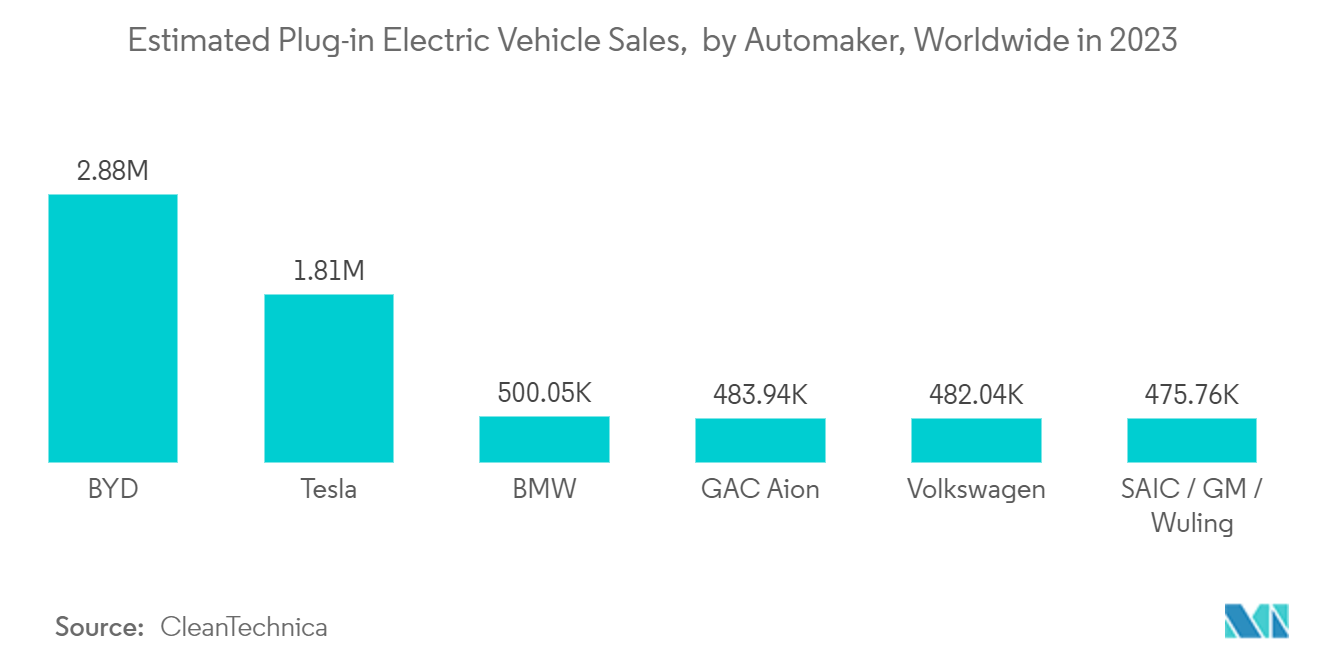
North America Occupies the Largest Market Share
- The North American region occupies the most significant market share, primarily due to the technological advancements and rising technological penetration among users, as well as growing demand from end-user segments, such as automobiles, aerospace, shipping, and railways, which are the primary growth drivers for the smart fabrics for the transportation market, in this region.
- Moreover, major players in this region have launched many efficient and highly advanced products compared to older products to deliver the prevailing services. Also, the emergence of information technology and increased usage of the Internet of Things (IoT) devices in automotive applications have added a whole new dimension to conducting business operations in this region. Also, deploying smart fabric functional systems based on IoT techniques is helping the transportation industry establish and maintain an operational process, directly boosting the market studied.
- Moreover, the region is witnessing a significant rise in the use of autonomous and electric automobiles. A rise in the usage of such vehicles will drive the demand for smart fabrics. This is expected to create ample opportunities for the market to expand and grow throughout the forecast period.
- The total revenue streams of Tesla, Inc., an American multinational automotive and clean energy company headquartered in Austin, Texas, reached approximately 81.5 billion U.S. dollars in 2022, with automotive sales accounting for over 67.2 billion U.S. dollars. Tesla, which began as Tesla Motors in 2003, is a brand of plug-in electric vehicles worldwide. This rise in such numbers will drive the market’s overall growth exponentially.
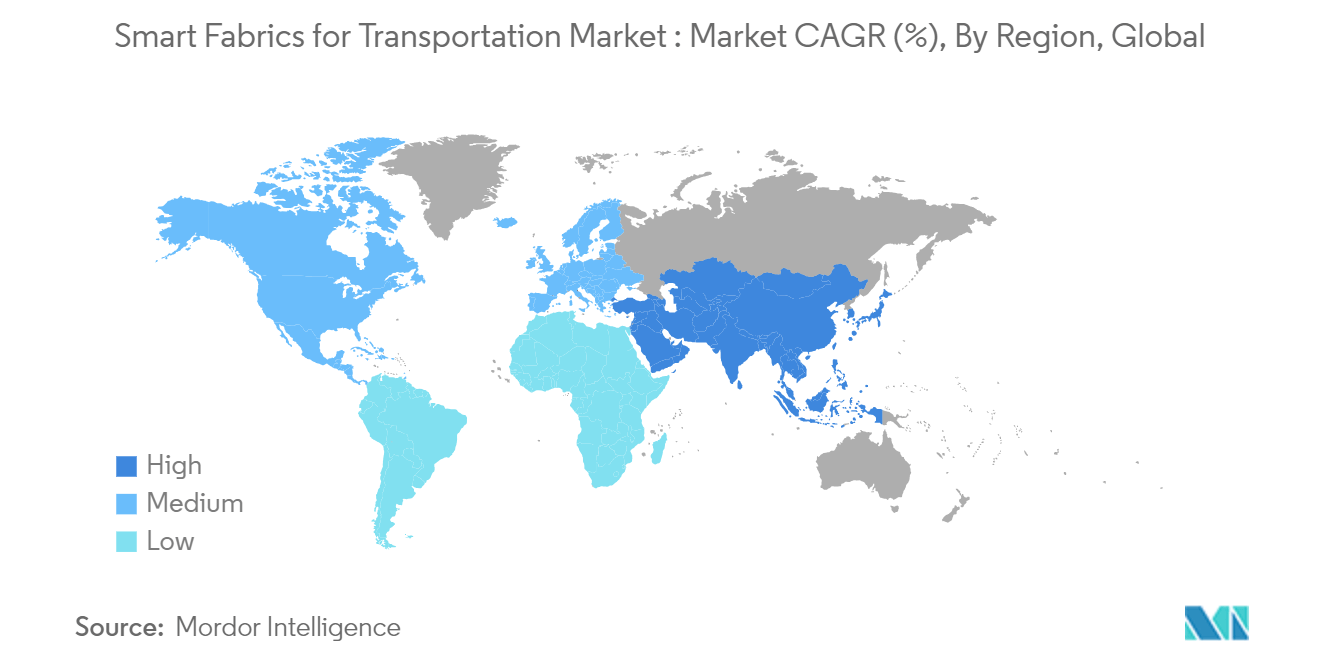
Competitive Landscape
In the competitive transportation market, smart fabric solutions have gained prominence, with numerous vendors operating domestically and internationally. The market exhibits a moderate level of concentration, but it is gradually moving towards a more fragmented state. Leading industry players employ key strategies centered around product design and innovation. Notable market participants include Kolon Glotech Inc., AIQ Smart Clothing Inc., and Interactive Wear AG, among others.
In February 2023, ThermoSiv introduced a cutting-edge smart fabric that sets a new standard in environmental efficiency. This innovative fabric emits heat in an eco-friendly manner, enabling clients in diverse sectors, including automotive and agritech, to conserve energy, enhance the user experience, and reduce costs. What sets ThermoSiv's fabric apart is its ability to precisely target and radiate heat to nearby objects, such as individuals or plants, thus ensuring their warmth without unnecessarily warming the surrounding air. The smart fabric from ThermoSiv is particularly beneficial for the automotive industry.
Smart Fabrics For Transportation Industry Leaders
-
AIQ Smart Clothing Inc.
-
Kolon Glotech Inc.
-
Interactive Wear AG
-
Schoeller Textil AG
-
Ohmatex
- *Disclaimer: Major Players sorted in no particular order
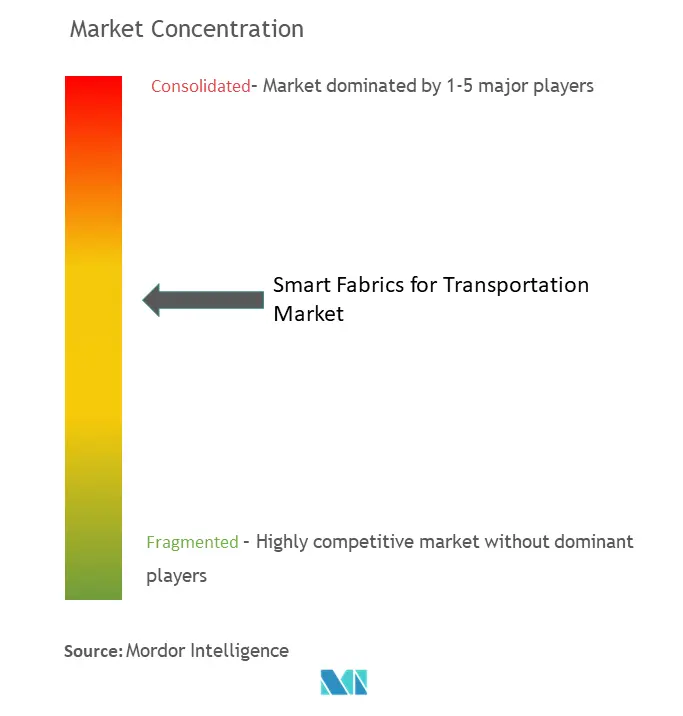
Recent Industry Developments
- March 2023: Apple's patent pertains to the integration of smart fabrics with a lighting system designed for incorporation into fabric seats, door panels, dashboards, and other interior components of systems like vehicles. This lighting system not only offers ambient illumination but also enables the creation of bespoke surface textures, decorative patterns, and the display of icons, text, and other information. Additionally, it supports custom gauge configurations.
- November 2022: Autoneum made a significant breakthrough by introducing a 100% polyester carpet, opening up new possibilities for vehicle manufacturers to meet their sustainability goals. These innovative carpet systems are fully recyclable, laying the groundwork for enhanced and more sustainable end-of-life recycling of electric vehicles.
Global Smart Fabrics For Transportation Market Report Scope
Smart fabrics are defined as textiles that can sense and react to external environmental conditions or stimuli from thermal, mechanical, chemical, magnetic, electrical, or other sources. They are able to respond and sense external conditions (stimuli) in a predetermined way.
The smart fabrics for transportation market is segmented by component (automobile interior carpets, automotive airbags, seat belt webbings, heated seats, and nylon tire cord fabrics), material (color-changing material, light-emitting materials, moving materials, and temperature changing material), application (mobility management, vehicle management, safety and security, and passenger information system), end-user industry (automobiles, shipping, railways, and aerospace), and geography (North America, Europe, Asia-Pacific, Latin America, and Middle East & Africa).
The market sizes and forecasts are provided in terms of value (USD) for all the above segments.
| Automobile Interior Carpets |
| Automotive Airbags |
| Seat Belt Webbings |
| Heated Seats |
| Nylon Tire Cord Fabrics |
| Color Changing Material (Photo Chromic Material and Thermo Chromic Material) |
| Light Emitting Materials (Electroluminescent Materials, Fluorescent Material, Phosphorescent Material, and Light Emitting Diodes (LED)) |
| Moving Materials (Conducting Polymers, Piezoelectric Material, Polymer Gel, and Shape Memory Alloys (SMA)) |
| Temperature Changing Material (Thermoelectric material) |
| Mobility Management |
| Vehicle Management |
| Safety and Security |
| Passenger Information System |
| Automobiles |
| Shipping |
| Railways |
| Aerospace |
| North America |
| Europe |
| Asia |
| Latin America |
| Middle East and Africa |
| By Component | Automobile Interior Carpets |
| Automotive Airbags | |
| Seat Belt Webbings | |
| Heated Seats | |
| Nylon Tire Cord Fabrics | |
| By Material | Color Changing Material (Photo Chromic Material and Thermo Chromic Material) |
| Light Emitting Materials (Electroluminescent Materials, Fluorescent Material, Phosphorescent Material, and Light Emitting Diodes (LED)) | |
| Moving Materials (Conducting Polymers, Piezoelectric Material, Polymer Gel, and Shape Memory Alloys (SMA)) | |
| Temperature Changing Material (Thermoelectric material) | |
| By Application | Mobility Management |
| Vehicle Management | |
| Safety and Security | |
| Passenger Information System | |
| By End-user Industry | Automobiles |
| Shipping | |
| Railways | |
| Aerospace | |
| Geography*** | North America |
| Europe | |
| Asia | |
| Latin America | |
| Middle East and Africa |
Key Questions Answered in the Report
How big is the Smart Fabrics For Transportation Market?
The Smart Fabrics For Transportation Market size is expected to reach USD 1.31 billion in 2025 and grow at a CAGR of 25.51% to reach USD 4.07 billion by 2030.
What is the current Smart Fabrics For Transportation Market size?
In 2025, the Smart Fabrics For Transportation Market size is expected to reach USD 1.31 billion.
Who are the key players in Smart Fabrics For Transportation Market?
AIQ Smart Clothing Inc., Kolon Glotech Inc., Interactive Wear AG, Schoeller Textil AG and Ohmatex are the major companies operating in the Smart Fabrics For Transportation Market.
Which is the fastest growing region in Smart Fabrics For Transportation Market?
Asia Pacific is estimated to grow at the highest CAGR over the forecast period (2025-2030).
Which region has the biggest share in Smart Fabrics For Transportation Market?
In 2025, the North America accounts for the largest market share in Smart Fabrics For Transportation Market.
What years does this Smart Fabrics For Transportation Market cover, and what was the market size in 2024?
In 2024, the Smart Fabrics For Transportation Market size was estimated at USD 0.98 billion. The report covers the Smart Fabrics For Transportation Market historical market size for years: 2019, 2020, 2021, 2022, 2023 and 2024. The report also forecasts the Smart Fabrics For Transportation Market size for years: 2025, 2026, 2027, 2028, 2029 and 2030.
Page last updated on:
Smart Fabrics For Transportation Market Report
Statistics for the 2025 Smart Fabrics For Transportation market share, size and revenue growth rate, created by Mordor Intelligence™ Industry Reports. Smart Fabrics For Transportation analysis includes a market forecast outlook for 2025 to 2030 and historical overview. Get a sample of this industry analysis as a free report PDF download.
